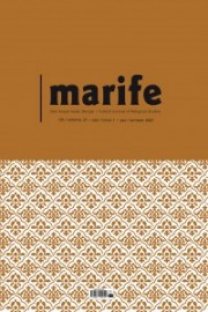Dijitalleşme ve Din
İletişim Teknolojisi, Sekülerleşme, İnternet, Din, Sanal Dünya, Sanal Din
Digitalleşme ve Din
communication technology, secularization, the internet, religion, the virtual world, the virtual religion,
___
- Akgül, Mehmet, ‘Medya ve Din: Radyo İletişimi ve Gözyaşı FM Örneği’, Türk İslam Medeniyeti Akademik Araştırmalar Dergisi, Konya, Yaz, Sayı: 6, 2008, ss:39-86.
- Altheide, David L. ve Snow, Robert P., Media Worlds in The Postjournalism Era, Aldine de Gruyter, New York 1991.
- Bunt, Gary.R., Dijital Çağda İslam,(çev: Nil Erdoğan) Babil Yayınları, İstanbul 2007.
- Campell, Heidi A., When Religion Meets New Media, Routledge, New York 2010.
- Ferre, John. P., ‘When Religion Meets New Media’, Journalism and Mass Communication Quarterly, Volume:87. Issue:3/4. Autumn. 2010, pp.689-690.
- Haberli, Mehmet, Sanal Din; Tarihsel, Kuramsal ve Pratik Boyutlarıyla İnternet ve Din, Açılım Kitap. İstanbul 2014.
- Hangen, Tona J., Redeeming The Dial: Evangelical Radio and Religious Culture:1920-1960, Doktora Tezi, Brandeis University (UMI microform,9927225), 1999.
- Hamelink, Cees, J.,’The Digital Advance’, UN Chronicle. Volume:35 ,Fall, 1998, ss. 20-25.
- Gaddy, Gary D., The People in the Electric Church: A Secondary Analysis of National Survey Data on the Audience of Religious Radio and Television, Master Tezi, CBN Universty, 1980.
- Güngör, Erol, Kültür Değişmesi ve Milliyetçilik, Ötüken Neşriyat: İstanbul 1990.
- Habermas, J., İdeoloji Olarak Teknik ve Bilim, çev. Mustafa Tüzel, Yapı Kredi yayınları, İstanbul 1993.
- Işık, Metin, “Kitle İletişim Araştırmalarının ve Din Sosyolojisinin Bir Sentezine Doğru”, Selçuk İletişim, cilt:1, sayı. 3, 2000, ss.117-121. (Daniel A.Stout ve Judith M. B.uddenbaum, Religion and Mass Media, Sage Publication, California 1996, ss.3-11’in çevirisi)
- Işık, Hüseyin, H., Tam İlmihal: Saadet-i Ebediye, Işık Kitabevi, İstanbul 1978.
- Kur’an-ı Kerim, Rum Suresi, Ayet: 41.
- McDonnell, Jim, ‘”Campbell Heidi A. Digital Religion; Understanding Religious Practice in New Media Worlds”, Communication Research Trends, Volume:33, Issue: March, 2014, .pp.34-39.
- Matelski, Marilyn J. ve Lynch ,Nancy, Messages From Underground: Transnational Radio in Resistance and in Solidarity, Westport CT 1997.
- Not Available “Theological and Religious Perspectives on the Internet”, Communication Research Trends, Volume:31, Issue:1 March, 2012. pp:3-5. (Centre for the Study of Communication and Culture).
- Roberts, K., Religion in Sociological Perspective,3rd ed. Belmont, CA:Wadsworth 1995.
- Roszak, Theodore, Bilincin Evrimi, çev. Bedirhan Muhib, İnsan Yayınları, İstanbul 1995.
- Russo, Christine J., “National Religious Broadcasters”, Afterimage, Volume: 22. Issue: 7-8, 1995, s.6.
- Stark, R. ve Iannaccone, L.R., “A Supply-Side Reinterpretation of the Secularization of Europe”, Journal for the Scientific Study for Religion, 33, 1994, ss. 230-252.
- Şişman, Nazife, Dijital Çağda Müslüman Kalmak, İnsan Yayınları, İstanbul 2016.
- Tomlinson, John, Küreselleşme ve Kültür, çev. Arzu Eker, Ayrıntı Yayınları, İstanbul 2004.
- Virilio, Paul, Enformasyon Bombası, çev. Kaya Şahin, Metis yayınları, İstanbul 2003.
- Yayın Aralığı: 2
- Başlangıç: 31.05.2001
- Yayıncı: Yediveren Kitap
Ebu Amr ed-Dânî’nin et-Tahdîd fi’l-İtkâni ve’t-Tecvid’i Özelinde Tecvid İlminin Müstakilleşmesi
“Tehzîbü’l-Ahlâk” Eserlerinin Ahlâk Eğitimi Açısından Değerlendirilmesi
William James’te Hakikat Problemi
Osmanlı Dönemi Medreselerinde Hadis Eğitimine Entelektüel Bir Katkı: Şerh ve Hâşiye Yazıcılığı
Mu’tezile Ekolünün İhbât ve Tekfîr Görüşlerine Eleştirel Bir Yaklaşım
